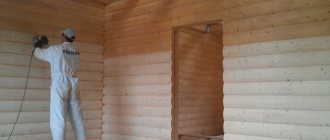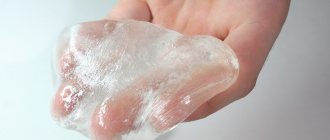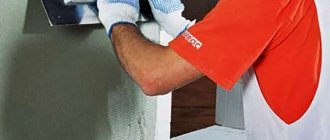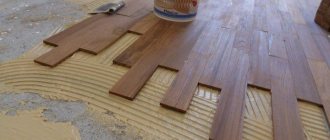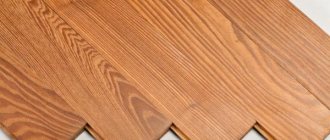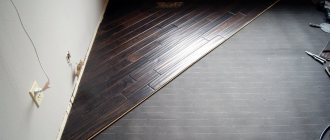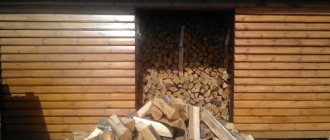Deck board platform
Compared to a platform made from ordinary floorboards, a platform made from deck boards will have the following advantages:
- better insulation - the material retains heat and absorbs noise;
- lasts longer under conditions of changing humidity and temperature levels. For example, a deck board in a bathroom will not lose its appearance for several decades;
- much more resistant to moisture. Regular cleaning, direct contact with water, frequent precipitation - these are exactly the conditions for which deck boards are created;
- less susceptible to rotting and corrosion, which means it will not require additional costs during operation.
Taking into account the above points, ordinary floorboards are used indoors, and deck boards are used in open areas, for example, when arranging a balcony, terrace, porch, or in places where a high level of humidity is expected - for a bathroom, when arranging a private pier, swimming pool, sauna.
Insulation with roll materials
Roll materials are a film or fabric base impregnated with a special insulating compound. The cheapest are roofing felt and roofing felt, but they have a short service life. Laying roll-type waterproofing materials is more difficult and takes more time. However, construction work can continue the very next day after installation of the insulation. The most modern materials are isoelast, mostoplast, ecoflex, isoplast. The installation process begins with preparatory work: drying the subfloor, priming. As a result of using roll insulation, the level rises by 0.3-0.5 cm.
The material is secured by an adhesive layer. Self-adhesive materials are produced. During installation, the protective film is removed and the insulator is glued to the base. Another type is fused insulators. Their installation occurs under the influence of high temperatures; a gas burner is usually used. The adhesive layer applied to the insulator melts and the material is attached to the base. The installation of floating waterproofing is more difficult and requires certain skills.
During the installation process, the roll insulation is attached with a construction stapler or fused to the lower part of the wall. In this case, be sure to cover the joints of the lower panels with the top layer.
Deck board in the apartment
The wooden floor in the apartment provides coziness and comfort, and the interior of such apartments is original. For finishing, parquet, tongue and groove, engineered or deck boards are used, depending on the purpose of the room.
Deck boards in an apartment have a number of advantages compared to other types of finishing. It is easy to install, especially in comparison with parquet boards. No preliminary preparation is required for laying deck boards; the floor can be laid directly on metal, concrete, or wooden bases. The main thing is that they are even. In addition, a deck board in an apartment is a smart investment.
The natural protection of this material from rotting, corrosion, rodents and insects will allow you to enjoy the impeccable appearance of the room for decades without additional costs.
Tree
If you choose natural wood, you won't go wrong. The pattern on the floor surface will be very beautiful and, no less important, absolutely unique. In addition, by choosing a really expensive tree, you will get a coating that can last a very long time - species such as teak, merbau or rosewood can last up to a hundred years. Hardwood floors last less, but still for a very long time - up to twenty-five years.
The disadvantages of natural coating always include its high cost. However, even artificial decking cannot be cheap. Much more important is the fact that wood requires constant care. Wood can dry out, change its color when exposed to ultraviolet radiation, and wear out from mechanical stress. To avoid such consequences. The floors will have to be treated with a special impregnation or oil, and on the reverse side, before installation, all wooden elements are treated with antiseptic mixtures. The outside of the planks is coated with varnish to protect them from water.
Bathroom Deck Board
The most common order our specialists receive is deck boards for the bathroom. This is a great alternative to tiles because decking in the bathroom will not require artificial heating and will create a pleasant woody smell in the room.
As for appearance, wooden flooring has a number of undeniable advantages; it is not without reason that this material is used for finishing saunas, swimming pools and yachts. Of course, natural materials cannot be cheap. Prices for this material cannot be low, but our company can guarantee the best price/quality ratio and delivery without prepayment on the day of order.
Application of underfloor heating system
If desired, you can install a heated floor system inside the bathroom in a wooden house. If you choose the option of electric floors, then most often the system is mounted on infrared film. In this case, you don’t even need to fill the screed.
Warm floor system diagram
When choosing water floors, the floor installation method is preferable. Special flooring mats made of polystyrene foam are placed on the prepared base, then pipes are laid in them. Next, the flooring system is covered with sheets of moisture-resistant plasterboard. The resulting structure will serve as the basis for finishing.
In addition to ensuring a comfortable temperature in the room, communications can be hidden in the underfloor heating system. Any moisture-resistant materials can be used as finishing materials: linoleum, ceramic tiles, moisture-resistant laminate.
Warm floor
Deck fence
Another unexpected modern solution for a country house could be a fence made from deck boards. Different types of wood can be used to make deck boards, the most popular of which are larch and pine. At the request of the client, the board can be made of valuable wood. If independently calculating and ordering the required quantity of deck boards causes difficulties, our managers will always provide the necessary advice and make recommendations. You can contact the company either through the form on the website or by phone.
Linoleum
Linoleum is the most economical flooring option. The moisture-resistant material has a long service life and low flammability. There are many colors of linoleum available, but for the bathtub of a wooden house it is better to choose a pattern that imitates plank flooring. Linoleum from commercial series will have greater wear resistance.
The material is laid on top of the waterproofing layer. If the room area in a wooden house is large, the joints of linoleum are joined by hot welding.
Features of installing garden parquet
The specified covering can be mounted on any base, it can be either a plank floor, a concrete screed, sand, gravel or just soil. This is due to the fact that the base of garden parquet is plastic and is not afraid of moisture.
Before installation, it is necessary to level the base, and then installation is carried out according to the type of designer.
During installation, you can alternate horizontal and vertical stripes, thus creating a beautiful coating pattern. A gravel cushion is better than a sand cushion, since tiles can be pressed into the sand; in any case, the cushion should be well leveled and compacted.
There is garden parquet that can be attached to joists; such a covering can easily be removed for the winter. When laying on the ground, it must be cleared of weeds, leveled and laid with geotextile fabric, which will prevent grass from sprouting.
The easiest way to lay garden parquet is on a concrete base, which should be smooth and clean.
The presence of simple and reliable locks allows you to install such a coating very quickly and even a beginner can cope with this work.
Required tools and materials
To install this coating, you will need the following tools and materials:
- to cut boards, you need an electric hand saw;
- drill or screwdriver;
- roulette;
- building level;
- special clips;
- self-tapping screws;
- logs, it is better to take those made of polymer materials;
- oil for additional surface coating.
When drilling holes for self-tapping screws, their diameter should be smaller than the diameter of the fastener.
The most common mistakes made during installation:
- the gaps intended for water drainage and ventilation are not observed;
- the distance between the logs is not maintained;
- the boards are laid close to the wall or to an adjacent base;
- There are no drainage holes along the edges of the boards;
- very strong connection of clips or screws.
Useful tips and tricks
Before you start laying decking boards yourself, it makes sense to familiarize yourself with various useful tips and recommendations related to carrying out this work. Perhaps it is simple tips that will allow you not to encounter serious problems and find answers to your questions.
Installing deck boards yourself is not as easy as it might seem
In this matter, it is very important to adhere to the correct technique and act competently. If a master doubts his skills and is afraid of ruining not the cheapest material, then it is better to refuse “homemade products” and call specialists.
The master should know that clamps are placed on absolutely all lags
If you do not follow this rule, then subsequently the laid floorboard will simply begin to bend.
It is recommended to ensure that the clamps fit neatly into the grooves of the decking boards. This ensures a more reliable and strong fastening, as well as the required gap between the individual boards.
It is important to ensure that the decking board does not remain submerged in water for more than 4 days. This requirement is especially important if the material was used to finish the area around the pool.
- Terrace boards, like any other facing material, must be kept clean. To clean and remove dirt from boards, you should not use metal sponges, scrapers that look like dull knives, or spatulas. It is better to take a regular piece of cotton or microfiber cloth. Such products will not harm the boards and will not leave scratches or chips on them.
- If certain defects appear on the decking board, for example, cigarette marks, then you can get rid of them using sandpaper.
- To wash decking boards, it is recommended to use only ordinary clean, running water. Only non-abrasive detergents that do not contain aggressive acids are suitable.
- If you need to choose the ideal boards for cladding the area around the pool or the façade base, you should give preference to decking made from hard wood. The coatings are more practical and wear-resistant.
- Terrace boards can be composite or made purely from solid wood. Both materials selected for future finishing work must be of high quality. It is recommended to choose branded products that are free from defects or damage. Low-quality boards will not last long, and they will look downright cheap.
- Select decking boards that have the appropriate size and thickness. If necessary, excess can be cut or sawed using special wood tools.
- If you have prepared the foundation for future installation work, then you can deliver a set of joists and planks to the site. These components must lie down for a while to allow the necessary acclimatization process to take place.
- If the terrace board is installed inside a heated room, then it can be coated with high-quality parquet varnish. It must be applied in several layers (at least 2).
- Terrace boards can be combined with heated floors.
- Handle wooden materials with care. Try not to drop or scratch the brand new deck boards. They must be installed strictly according to the instructions.
- The technological gap, which must be provided at the stage of installing the logs, must be at least 2 cm. It is in this gap that gutters or curbs will be based, so you cannot forget about such components.
- If you are choosing a decking board for a place where a lot of people move, then it is advisable to give preference to high-density specimens. Most often, these types of coverings are installed in areas around gazebos, terraces or residential buildings.
- If you decide to install insulation under the cladding mounted on the facade base, then it can be attached using an adhesive solution, as well as mushroom dowels with a metal rod.
In the next video you will learn the rules for installing decking boards made from natural materials.
Terrace board (decking): concept, types and installation methods
The building materials market is constantly evolving and relatively recently it has introduced such flooring as decking boards, which can be created in several ways: from natural wood, by impregnation, steam treatment and by combining wood and polymer (WPC)
The result is a material that is not afraid of moisture, cold and heat, does not rot, does not crack or warp. In addition, decking boards or decking have an affordable price, since they are made from industrial wood waste and contain about 30% polymers.
To create such a material, the polymer is melted, mixed with wood shavings and everything is poured into special molds, and the presence of additives allows for a long service life of the decking board.
This material can be used to cover terraces, balconies, dressing rooms, around the pool, to create garden paths, and its service life is 50 years or more.
To relieve stress that occurs when temperature and humidity changes, longitudinal grooves are made on the underside of the board.
This is an environmentally friendly material, since no hazardous components are used in its production. Both sides of such a board can be front-facing, which is very convenient during installation.
Dimensions
Typically this material is produced:
- thickness from 24 cm to 4 cm;
- length from 1.5 m to 6 m;
- width from 140 mm to 160 mm.
